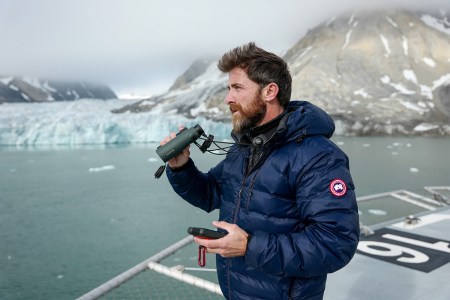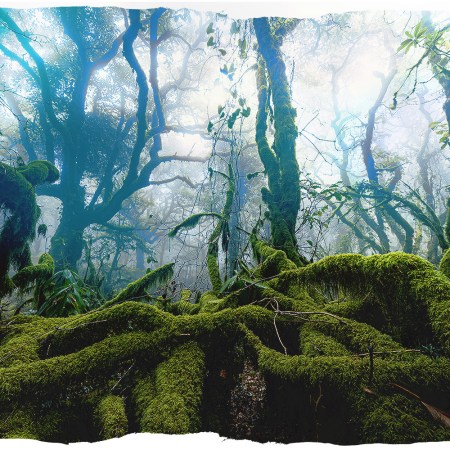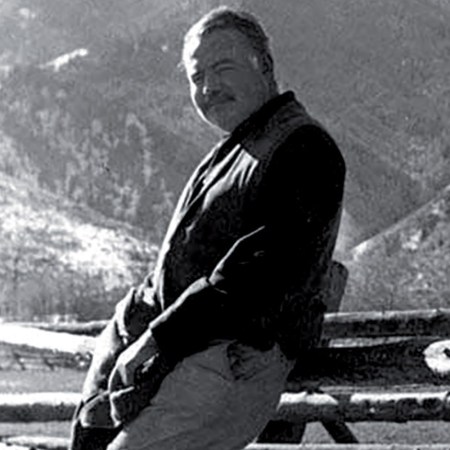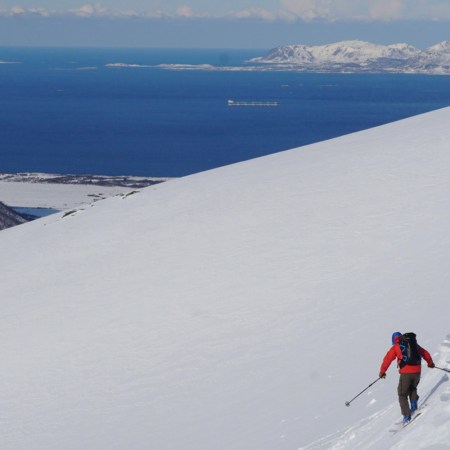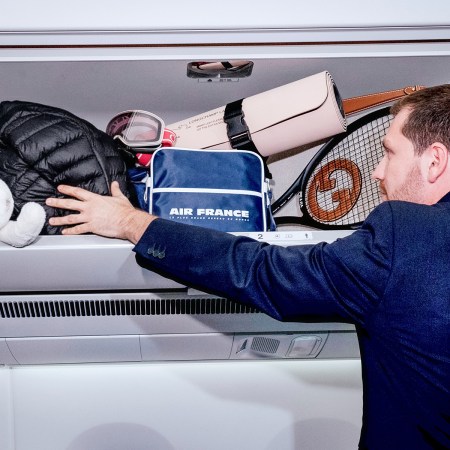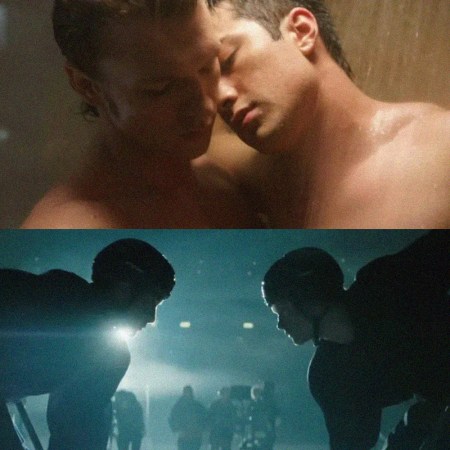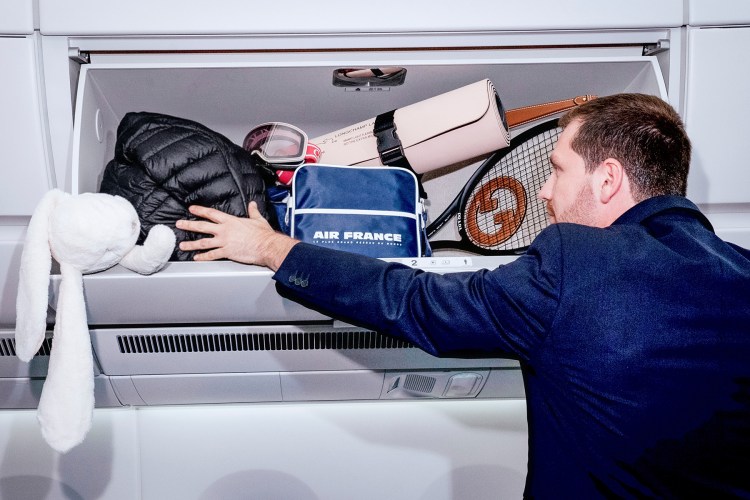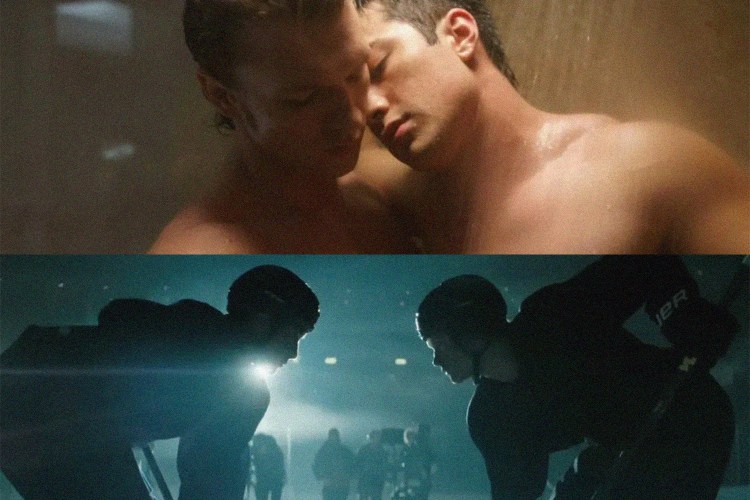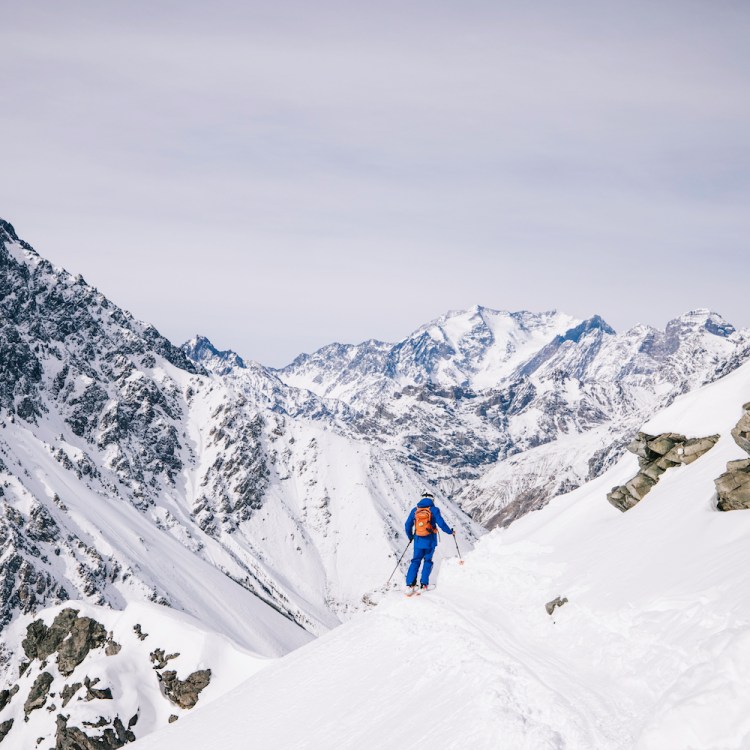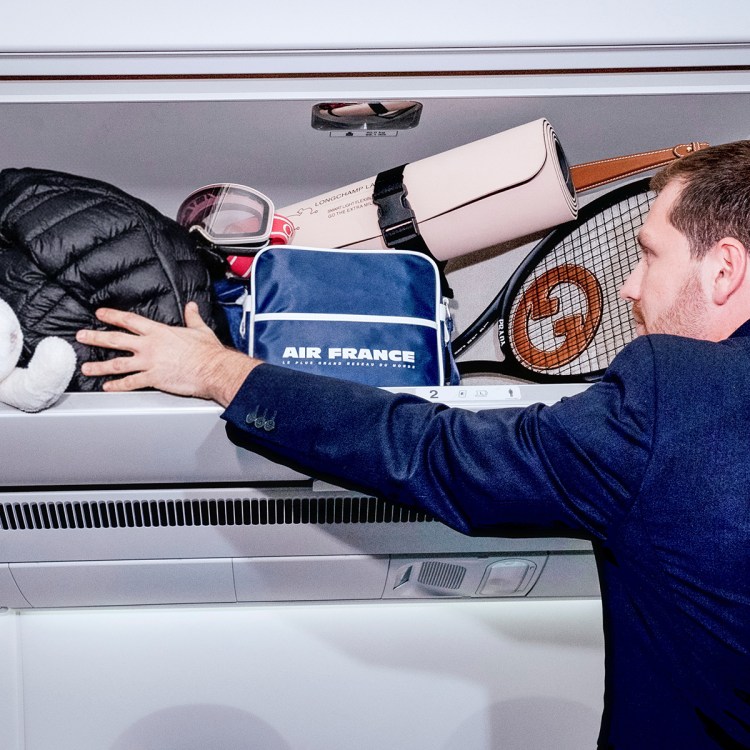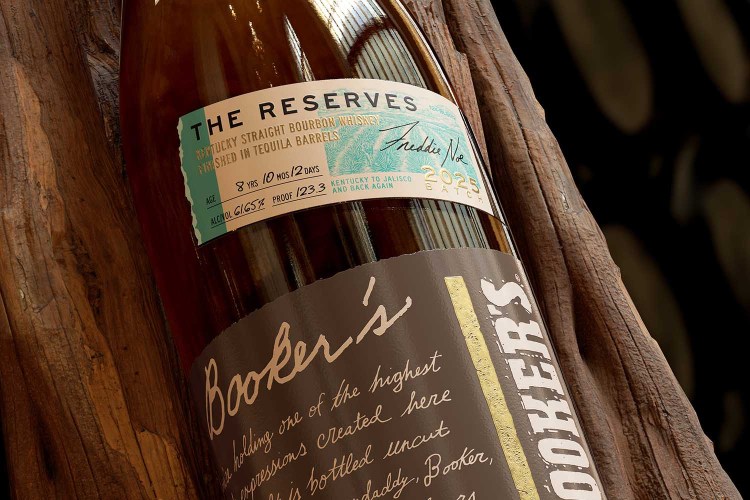I’m standing on my Ski-Doo snowmobile somewhere in the Venn diagram that entwines Idaho, Montana and Wyoming. As the engine idles between my calves, I realize I’m lost on the top of a mountain. My helmet’s face shield is flipped up, but the track I laid to get up here, perhaps a lifeline to the group I sped away from, is imperceptible in the snow. Except for the wind rattling around my helmet, it’s very quiet; I remove it, but still can’t hear the other snowmobiles rumbling in the distance. By now, being lost is a few minutes old, so I get off to walk around. All I see are valleys covered in snow above embankments of conifers and these eerie ghost trees.
Fun as it was doing 75 miles per hour uphill, I regret leaving the group. It’s mid-March and I’m on the Mount Two Top trail, part of a series of trails that weave between Custer Gallatin and Caribou-Targhee National Forests, just outside of Yellowstone National Park. The series of groomed trails I’ve been riding for about 45 minutes weaves along the Continental Divide separating Montana and Idaho. It’s my second time on a Ski-Doo — the first was 24 hours earlier, straddling a different rental through Yellowstone National Park. But now, about 2,000 feet up, the snow can reach 10 feet deep with temps as low as 60ºF below. It’s been a few minutes longer now, and I’m a little nervous. I can’t gather my bearings enough to tell where I am or how to get back, yet I stop short of screaming “hello.”

It’s warm today, with blue skies, which I take a second to appreciate becaue I can see about seven mountain ranges in the distance. All you have to do is look out past the snow ghosts — 20-foot-tall conifers dragooned into twisted shapes by snow and freezing winds. Up here, they guard this citadel of quiet, white nothingness. I don’t know any of Idaho’s mountains and, frankly, I’m not even sure which state I’m looking at. But I do notice Wyoming’s Grand Tetons off in the distance. When we stopped to regroup about 20 minutes ago, I remember taking a selfie with them.
My bearing back, I humbly drove my ass back down to the pack of about 10, most of whom were carving tracks into powder. That’s when I realized why these machines are quiet enough to be let into Yellowstone National Park. And that I was far less afraid yesterday, when I was slowly rolled by a bison.
Solitude, or at least a different perspective, is part of the reason you visit the park in the winter. If you think Disney World is crowded, Yellowstone sees about a million visitors a month in June and July, with another 1.7 million between August and September. That’s about half the park’s annual visitation crammed into America’s summer vacation. And sure, Yellowstone’s about the size of Rhode Island and Delaware combined, but it can feel like one guy is using the restroom and the 99,999 other folks are crowded around you waiting to see Old Faithful. In winter, the park averages about 50,000 guests.

I cruised up to Yellowstone’s western entrance on a snowmobile as part of a group following a guide. Yes, it’s cold out, but the 40º below snowsuit I’m wearing makes it tolerable to be outside all day. Also, don’t underestimate how comfortable the heated hand grips on the Ski-Doo are.
Mid-December to mid-March is Yellowstone’s shoulder season. November snow closes most of the roads in the park, but just before Christmas, the asphalt routes are groomed for snow travel. The park began funneling winter visits through tour operators back in 2004, and the snowmobile rental locations are based largely in West Yellowstone just outside the park. It’s not the only way to experience Yellowstone in winter though. Intrepid locals can still cross-country ski into the park for the day. Some choose to sleep in a heated yurts and ski, while others snowshoe around trails. There are more luxurious accommodations towards the northeast entrance of the park that offer day trips to see Lamar Valley, a prize swath for spotting animal activity that snowmobiles don’t usually access.
But today, I’m one of about 30, organized in neat rows, pulled off to the side waiting for our guides to handle the entrance paperwork with a ranger. I take photos with the iconic Yellowstone signage, which must be brown according to Section 2A-27 of the park service’s sign manual. It looks like a used car lot for snowmobiles out here, as it must each morning. Regardless of the tour company you’re with, the chances are you’ll be on a Ski-Doo during your visit because it’s essentially the only manufacturer who makes a machine efficient and quiet enough to meet federal standards. Later we’ll see guests on the other motorized tour option, a short bus called a snow coach that rides on low-pressure tires large enough to be in a CrossFit gym.

I’m here with Yellowstone Vacations’ snowmobile tour, which is a few feet away from my hotel in West Yellowstone. The town is only about a mile away from the gate to the park and has almost as many snowmobiles on the street as it does cars. In town, everywhere you look (and walk) there is a layer of compacted snow — the asphalt isn’t gentle on the snowmobile’s tank-like tread. You learn this while driving through West Yellowstone on a snowmobile to get to the gate, and, no, the Ski-Doo does not have blinkers or a horn. Other tour operators in town, like Yellowstone Adventure and Three Bear Lodge, also run guided winter tours.
Most of the tour operators run similar versions of Yellowstone’s two main routes into the park. The most popular is the 65-mile round trip to Old Faithful, but the longer, 90-mile route to the Grand Canyon of the Yellowstone is gaining in popularity. Both options are all-day affairs, where you check in, rent clothing if you don’t have your own, get on the snowmobiles by about 9 a.m., see the park all day and return at about 4 or 5 p.m. While at Old Faithful, you can stop for lunch at the Old Faithful Snow Lodge, but box lunches are more common on the longer, Grand Canyon of the Yellowstone tour.
The High-Stakes Adventures of Aldo Kane, Nat Geo Explorer
The former Royal Marine sniper talks about his new show with James Cameron, diving with sharks and what he learned from Alex Honnold
The National Park Service sets efficiency standards for snowmobiles allowed into Yellowstone, which is the only park that accommodates guided tours. Other national parks, like Acadia, Crater Lake, Mount Rainier and Rocky Mountain, allow snowmobiles in but usually don’t have an extensive network of rental locations or tours. Except for a couple of nearly 10-year-old Yamahas, Ski-Doo is the only manufacturer that meets emissions levels and the park’s mandate of a mean 67 decibel operation level (without going over 69 dBA).
How loud is 67 decibels? A vacuum cleaner is about 70. You can chat with someone while the machine idles and have a conversation at about 20 miles per hour, which is reassuring for those in the back seat of the 2025 Grand Touring Sport 900 ACE model, the most common rental version. There’s no age limit to drive the snowmobile, aside from having a full, unrestricted license, but those younger than 18 need a guardian to sign the paperwork; passengers must be at least five years old.
The first few miles are slow going as you get used to the 900 ACE Ski-Doo, though there’s not much to it. The turns are gentle and sweeping, and driving the snowmobile feels a lot like an EV: There’s less braking involved and more letting off the throttle as the machine slows to a halt. The speed limit in the park for snowmobiles is 35 miles per hour and it feels plenty fast. The point isn’t going fast though, it’s the opposite, which you can take advantage of without a caravan of cars behind you.

The tour stops frequently to take photos, and guides give context to what you’re seeing, including the story about Yellowstone’s early name, Colter’s Hell. Often your tour pulls off to the side to let oncoming snowmobile traffic pass, to go around snow coaches or stop for Yellowstone traffic jams.
After exploring Madison Junction, we pulled off to the side of the road. A few large bison have caused the standstill and didn’t seem to be in a rush as they looked out on dozens of snowmobile riders, smartphones in hand, and the snow coach’s passengers all snapping photos. Cruising 10 feet in front of a wild, 2,000-pound bull — that’s nearly 2.5 times the weight of me and the Ski-Doo I’m on — was remarkable. I’ve fed bison before, but this was an eye-to-eye encounter.
We bank a left towards the Lower Geyser Basin and walk the path around the Fountain Paint Pots where you can see the hydrothermal evidence of Yellowstone’s simmering volcano. The afternoon is filled with a lot of yanking the snow gloves off, which I wish were touch screen compatible, and reaching for the phone in the Ski-Doo’s glove box. Because of a hydrothermal explosion last summer, Biscuit Basin is off limits.

Our guide is trying to time our arrival at Old Faithful to coincide with an eruption. As we pull into the parking lot of the Visitor Education Center, we see a dramatic structure with low-slung roofs that looks even more so with a wall of snow rising from the floor to touch it. The timing was perfect: After a 15-minute wait, Old Faithful goes off with all the drama I experienced in the summer. What was different? In August the collective “oohs” are loud enough to drown out the sound of the geyser, but in March it’s quiet enough to hear the steam escaping from the earth. We walk to lunch at the Obsidian Dining Room inside the Old Faithful Snow Lodge. It’s a full menu today, with a lot of bison on tap and a gas fireplace roaring within in a modern space that still keeps with Yellowstone’s rustic park-itecture look.
After lunch, it’s a retracing of the route we took into the park. Wolves are a rare site in the southeast corner of Yellowstone, but we stopped to spot a couple of coyotes out along the river, stepping confidently and gracefully into the snow. A bit further on, more bison gathered on a patch of grass on the banks. At Firehole Canyon, a popular swimming spot in the summer, the water is moving and peaceful. It’s far more tumbling at Firehouse Falls, which was the most dramatic vista offered up today. It’s a long drive out of the park and back to the yard at Yellowstone Vacations, but the few bumps never really hit you because of the suspension on the Ski-Doo.

With a full day of riding under my belt, I was ready for a little more speed, which you can have during certain stretches while on the Two Top trail. Outside the park, this groomed trail system is a favorite for locals, and some outfitters offer tours here. I’m on a zippier 2026 MXZ Neo Ski-Doo for this tour, and the route today is narrower, twistier and at higher elevation, which means colder. On this day’s ride, there’s more leaning into turns, which means sliding your butt off the seat.
As you climb, the trees change from normal green conifers to the snow ghosts. It’s a dramatic change that, save for the lack of precipitation falling, feels like a snow globe. The trails here open up as you get higher to open fields of white where you can give the snowmobiles as much gas as you want without much fear of colliding with another tour group. The grin I had hitting 65 miles per hour on one stretch wasn’t enough. And that’s where things got hairy.
Maxing out my weekend’s snowmobile speed to the top of a mountain had me lost for a moment, but I appreciated the access these capable machines provided — just not nearly as much as the unmistakable outline of the Grand Tetons.
This article appeared in an InsideHook newsletter. Sign up for free to get more on travel, wellness, style, drinking, and culture.


